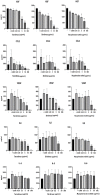The Effects of Immunosuppressive Drugs on the Characteristics and Functional Properties of Bone Marrow-Derived Stem Cells Isolated from Patients with Diabetes Mellitus and Peripheral Arterial Disease
- PMID: 37509511
- PMCID: PMC10377428
- DOI: 10.3390/biomedicines11071872
The Effects of Immunosuppressive Drugs on the Characteristics and Functional Properties of Bone Marrow-Derived Stem Cells Isolated from Patients with Diabetes Mellitus and Peripheral Arterial Disease
Abstract
Background: Diabetic patients (DPs) with foot ulcers can receive autologous cell therapy (ACT) as a last therapeutic option. Even DPs who have undergone organ transplantation and are using immunosuppressive (IS) drugs can be treated by ACT. The aim of our study was to analyze the effects of IS drugs on the characteristics of bone marrow-derived stem cells (BM-MSCs).
Methods: The cells were isolated from the bone marrow of DPs, cultivated for 14-18 days, and phenotypically characterized using flow cytometry. These precursor cells were cultured in the presence of various IS drugs. The impact of IS drugs on metabolic activity was measured using a WST-1 assay, and the expression of genes for immunoregulatory molecules was detected through RT-PCR. Cell death was analyzed through the use of flow cytometry, and the production of cytokines was determined by ELISA.
Results: The mononuclear fraction of cultured cells contained mesenchymal stem cells (CD45-CD73+CD90+CD105+), myeloid angiogenic cells (CD45+CD146-), and endothelial colony-forming cells (CD45-CD146+). IS drugs inhibited metabolic activity, the expression of genes for immunoregulatory molecules, the production of cytokines, and the viability of the cells.
Conclusions: The results indicate that IS drugs in a dose-dependent manner had a negative impact on the properties of BM-MSCs used to treat ischemic diabetic foot ulcers, and that these drugs could affect the therapeutic potential of BM-MSCs.
Keywords: cell-based therapies; diabetes; diabetic foot ulcers; immunosuppressive drugs.
Conflict of interest statement
The authors declare no conflict of interest.
Figures





Similar articles
-
Bone marrow-derived mesenchymal stromal cells from patients with end-stage renal disease are suitable for autologous therapy.Cytotherapy. 2013 Jun;15(6):663-72. doi: 10.1016/j.jcyt.2013.01.010. Epub 2013 Feb 16. Cytotherapy. 2013. PMID: 23419679
-
Quantitation of progenitor cell populations and growth factors after bone marrow aspirate concentration.J Transl Med. 2019 Apr 8;17(1):115. doi: 10.1186/s12967-019-1866-7. J Transl Med. 2019. PMID: 30961655 Free PMC article.
-
Human embryonic stem cell-derived mesenchymal stroma cells (hES-MSCs) engraft in vivo and support hematopoiesis without suppressing immune function: implications for off-the shelf ES-MSC therapies.PLoS One. 2013;8(1):e55319. doi: 10.1371/journal.pone.0055319. Epub 2013 Jan 29. PLoS One. 2013. PMID: 23383153 Free PMC article.
-
[Effect of different transplantations with bone-marrow derived mesenchymal stem cells on diabetic foot ulcers in rats].Zhong Nan Da Xue Xue Bao Yi Xue Ban. 2013 Apr;38(4):347-55. doi: 10.3969/j.issn.1672-7347.2013.04.003. Zhong Nan Da Xue Xue Bao Yi Xue Ban. 2013. PMID: 23645234 Chinese.
-
[Immunosuppressive effects of fetal bone marrow derived mesenchymal stem cells on in vitro proliferation of adult peripheral lymphocyte and expression of immune-related factors].Zhonghua Xue Ye Xue Za Zhi. 2014 Oct;35(10):891-6. doi: 10.3760/cma.j.issn.0253-2727.2014.10.004. Zhonghua Xue Ye Xue Za Zhi. 2014. PMID: 25339324 Chinese.
Cited by
-
Utilization of convolutional neural networks to analyze microscopic images for high-throughput screening of mesenchymal stem cells.Open Life Sci. 2024 Jul 10;19(1):20220859. doi: 10.1515/biol-2022-0859. eCollection 2024. Open Life Sci. 2024. PMID: 39005738 Free PMC article.
References
Grants and funding
LinkOut - more resources
Full Text Sources
Research Materials
Miscellaneous

